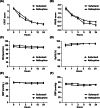Pain management of nalbuphine and sufentanil in patients admitted intensive care unit of different ages
- PMID: 35346051
- PMCID: PMC8961885
- DOI: 10.1186/s12873-022-00592-x
Pain management of nalbuphine and sufentanil in patients admitted intensive care unit of different ages
Abstract
Background: Pain relief for patients in the intensive care unit (ICU) can improve treatment outcomes and reduce the burden on doctors and nurses. This study aims to report the clinical analgesic and sedative effects of nalbuphine and sufentanil on ICU patients.
Methods: This study retrospectively analyzed the medical records of 87 critically ill patients who received nalbuphine or sufentanil infusion in the ICU, including demographic data, diagnosis, Acute Physiology and Chronic Health Evaluation (APACHE) II, Critical Care Pain Observation Tool (CPOT), Richmond Agitation-Sedation Scale (RASS), systolic and diastolic blood pressure, heart rate and blood oxygen saturation (SpO2). The primary outcomes of this study were CPOT and RASS scores. The secondary outcomes were hemodynamic changes, including systolic blood pressure, diastolic blood pressure, heart rate, and SpO2. The adverse events recorded during pain management, such as hypoxemia, respiration depression and bradycardia, were also collected and analyzed.
Results: None of the patients in both groups experienced episode of hypoxemia, respiration depression and bradycardia. However, age-stratified analyses showed that nalbuphine has a better analgesic effect than sufentanil for patients aged ≤ 60 (P < 0.05). In contrast, sufentanil showed a better analgesic effect than nalbuphine for patients aged > 60 ( P < 0.05). Furthermore, nalbuphine has a significantly better sedative effect than sufentanil for patients aged ≤ 60 (P < 0.05).
Conclusion: ICU patients of different age groups may be suitable for different analgesics. For patients under the age of 60, nalbuphine has better analgesia and sedation than sufentanil, and does not cause respiratory depression and drastic hemodynamic changes.
Keywords: Analgesia; Intensive care unit; Nalbuphine; Sedation; Sufentanil.
© 2022. The Author(s).
Conflict of interest statement
None. All authors declare that there is no conflict of interest.
Figures


Similar articles
-
[Efficacy and safety of nalbuphine on analgesia of patients in intensive care unit].Zhonghua Wei Zhong Bing Ji Jiu Yi Xue. 2018 May;30(5):471-476. doi: 10.3760/cma.j.issn.2095-4352.2018.05.015. Zhonghua Wei Zhong Bing Ji Jiu Yi Xue. 2018. PMID: 29764554 Chinese.
-
Safety and Efficacy of Sufentanil and Fentanyl Analgesia in Patients with Traumatic Brain Injury: A Retrospective Study.Med Sci Monit. 2022 May 13;28:e934611. doi: 10.12659/MSM.934611. Med Sci Monit. 2022. PMID: 35550501 Free PMC article.
-
Nalbuphine 20 mg combined with sufentanil 2 μg/kg exerts a better postoperative analgesia effect in patients undergoing a second cesarean section: a randomised trial.Ann Palliat Med. 2022 Oct;11(10):3213-3223. doi: 10.21037/apm-22-1026. Ann Palliat Med. 2022. PMID: 36367004 Clinical Trial.
-
[New opioids for general anaesthesia and in- and out-hospital analgesia].Anestezjol Intens Ter. 2008 Jan-Mar;40(1):39-43. Anestezjol Intens Ter. 2008. PMID: 19469098 Review. Polish.
-
Nalbuphine's Hemodynamic Impact in Ear, Nose, and Throat (ENT) Surgeries: A Comprehensive Review.Cureus. 2024 Jan 22;16(1):e52755. doi: 10.7759/cureus.52755. eCollection 2024 Jan. Cureus. 2024. PMID: 38389632 Free PMC article. Review.
Cited by
-
Nalbuphine in Pediatric Emergence Agitation Following Cochlear Implantation: A Randomized Trial.Drug Des Devel Ther. 2024 Jul 8;18:2837-2845. doi: 10.2147/DDDT.S451089. eCollection 2024. Drug Des Devel Ther. 2024. PMID: 39006192 Free PMC article. Clinical Trial.
-
Patient-controlled intravenous administration of dexmedetomidine with nalbuphine versus sufentanil for post cesarean delivery analgesia: A retrospective observational study.Kaohsiung J Med Sci. 2023 Jul;39(7):740-747. doi: 10.1002/kjm2.12689. Epub 2023 Apr 24. Kaohsiung J Med Sci. 2023. PMID: 37092309 Free PMC article.
-
Comparative Analysis of the Postoperative Analgesic Effect of Caudal Ropivacaine Versus Ropivacaine With Nalbuphine in Infra-Umbilical Pediatric Surgeries: A Randomized, Double-Blind Pilot Study.Cureus. 2024 Dec 24;16(12):e76311. doi: 10.7759/cureus.76311. eCollection 2024 Dec. Cureus. 2024. PMID: 39850200 Free PMC article.
-
Co-Administration of nalbuphine to improve morphine tolerance in mice with bone cancer pain.Mol Pain. 2023 Jan-Dec;19:17448069231178741. doi: 10.1177/17448069231178741. Mol Pain. 2023. PMID: 37226458 Free PMC article.
-
Pharmacological Pain Treatment in Older Persons.Drugs Aging. 2024 Dec;41(12):959-976. doi: 10.1007/s40266-024-01151-8. Epub 2024 Oct 27. Drugs Aging. 2024. PMID: 39465454 Free PMC article. Review.
References
-
- Payen JF, Bosson JL, Chanques G, Mantz J, Labarere J, Investigators D. Pain assessment is associated with decreased duration of mechanical ventilation in the intensive care unit: a post Hoc analysis of the DOLOREA study. Anesthesiology. 2009;111(6):1308–1316. doi: 10.1097/ALN.0b013e3181c0d4f0. - DOI - PubMed
MeSH terms
Substances
LinkOut - more resources
Full Text Sources

